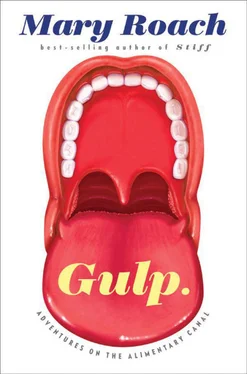In 1973, inquisitive cold researchers from the University of Virginia School of Medicine investigated “the frequency of exposure of nasal… mucosa to contact with the finger under natural conditions”—plainly said, how frequently people pick their nose. Under the guise of jotting notes, an observer sat at the front of a hospital ampitheater during grand rounds. Over the course of seven 30- to 50-minute observation periods, a group of 124 physicians and medical students picked their collective noses twenty-nine times. Adult Sunday school students were observed to pick at a slightly lower rate, not because religious people have better manners than medical personnel, but, the researchers speculated, because their chairs were arranged in a circle. In a separate phase of the study, the researchers contaminated the picking finger of seven subjects with cold virus particles and then had them pick their nose. Two of seven came down with colds. In case you needed a reason to stop picking your nose.
Fear the fight bite: it can cause septic arthritis. In one study, 18 of 100 cases ended in amputation of a finger. Hopefully the middle one. In the aggressive patient, a missing middle finger may be good preventive medicine.
The zookeepers, however, got very, very quiet. “So maybe,” said Bronstein in an e-mail, “the dragon spit some of its quietness spray on them.” I am almost 100 percent sure that that is not a reference to Sharon Stone.
The term quack derives from quacksalber , German for “quicksilver” (mercury’s nickname). It took a while for medicine to see the light. As late as 1899, the Merck Manual suggests mercury as an antisyphilitic, to “produce salivation.” Syphilitics weren’t the only ones salivating over mercury. Merck was, at the time, reaping profits from eighteen different “medicinal” mercuries.
Not to be confused with the Nutter D. Marvel Museum of horsedrawn carriages or the Butter Museum, a working farm that “showcases all things butter, from various styles of butter dishes to the history of butter through the ages,” perhaps turning away briefly during butter’s history-making 1972 role in Last Tango in Paris .
Fingerprints come in three types: loop (65 percent), whorl (30 percent), and arch (5 percent). Oral processing styles for semisolid foods come in four: simple (50 percent), taster (20 percent), manipulator (17 percent), and tonguer (13 percent). Thus the millions of variations that make you the unique and delightful custard-eater and fingerprint-leaver that you are.
I nominate Rhode Island.
Assuming equal terrain and baggage count, about as fast as a tortoise—.22 miles per hour.
Its full medical name, and my pen name should I ever branch out and write romance novels, is palatine uvula.
Technical term: toothpack.
1896 was a banner year for human-swallowing, or yellow journalism. Two weeks after the Bartley story broke, the Times ran a follow-up item about a sailor buried at sea. An axe and a grindstone, among other things, were placed in the body bag to sink the parcel. The man’s son, frantic with grief, plunged overboard. The next day, the crew hauled aboard a huge shark with an odd sound issuing from within. Inside the stomach, they found both the father and the son alive, one turning the grindstone while the other sharpened the axe, “preparatory to cutting their way out.” The father, the story explains, “had only been in a trance.” As had, apparently, the Times editorial staff.
I challenge you to find a more innocuous sentence containing the words sperm, suction, swallow, and any homophone of seaman . And then call me up on the homophone and read it to me.
Vallisneri named the fluid aqua fortis —not to be confused with aquavit , a Scandinavian liquor with, sayeth the Internet, “a long and illustrious history as the first choice for… special occasions,” like holidays or the opening of an ostrich stomach.
At some point during the experiment, or possibly the follow-up, wherein a live eel was pushed into the stomach and left with “just its head outside,” or one of the dozens of other vivisections, Bernard’s wife walked in. Marie Françoise “Fanny” Bernard—whose dowry had funded the experiments—was aghast. In 1870 she left him and inflicted her own brand of cruelty. She founded an anti-vivisection society. Go, Fanny.
Meaning “by way of the anus.” “Per annum,” with two n ’s, means “yearly.” The correct answer to the question, “What is the birth rate per anum?” is zero (one hopes). The Internet provides many fine examples of the perils of confusing the two. The investment firm that offers “10% interest per anum” is likely to have about as many takers as the Nigerian screenwriter who describes himself as “capable of writing 6 movies per anum” or the Sri Lankan importer whose classified ad declares, “3600 metric tonnes of garlic wanted per anum.” The individual who poses the question “How many people die horse riding per anum?” on the Ask Jeeves website has set himself up for crude, derisive blowback in the Comments block.
Those of you who swallow oysters without chewing them may be curious as to the fate of your appetizers. Mollusk scientist Steve Geiger surmised that a cleanly shucked oyster could likely survive a matter of minutes inside the stomach. Oysters can “switch over to anaerobic” and get by without oxygen, but the temperature in a stomach is far too warm. I asked Geiger, who works for the Florida Fish and Wildlife Research Institute, about the oyster’s emotional state during its final moments inside a person. He replied that the oyster, from his understanding, is “pretty low on the scale.” While a scallop, by comparison, has eyes and a primitive neural network at its disposal, the adult oyster makes do with a few ganglia. And mercifully, it is likely to go into shock almost immediately because of the low pH of the stomach. Researchers who need to sedate crustaceans use seltzer water because of its low pH. Geiger imagined it would have a similar effect on bivalves. But you might like to chew them nonetheless, because they’re tastier that way.
How remains a matter of debate. I had heard that pythons suffocate prey by tightening on its exhale and preventing further inhales. Secor says no; prey passes out too quickly for that to be the explanation. “You’d still have oxygen circulating in the blood, like you’re holding your breath.” He thinks it’s more likely that the constriction shuts off blood flow, more like strangulation than suffocation. An experiment was planned at UCLA but nixed by the animal care committee. Secor would volunteer himself. “I think we’d all like to have a giant snake constrict us in a controlled situation and see what happens—could we still inhale?” It’s possible he’s a little nuts. But in a good way.
Excuse me, I mean the Dried Plum Capital of the World. The change was made official in 1988, as part of an effort to liberate the fruit from its reputation as a geriatric stool softener. Yuba City has Vancouver, Washington, to blame for that. The original Prune Capital of the World, Vancouver was the home of the Prunarians, a group of civic-minded prune boosters who, back in the 1920s, touted the laxative effects of dried plums. The Prunarians also sponsored an annual prune festival and parade. A 1919 photo reveals a distinct lack of festiveness and pruniness. Eight men in beige uniforms stand in a row across the width of a rain-soaked pavement. A ninth stands on his own just ahead of the row, similarly attired. Presumably he is their leader, though you expect a little foofaraw from an entity known as the Big Prune. Or the Big Dried Plum, as Yuba City would like you to call him.
Читать дальше












